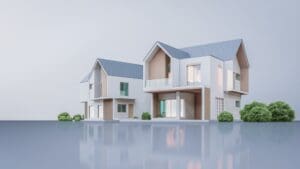Today, being the age of social media marketing and an increased social economy, people have a huge interest in smart home designs. Living spaces are evolving from the traditional spaces moving to smarter and intelligent homes.
This is where cloud rendering comes in to assist homeowners with digital home visualizations. Cloud rendering is the process of creating high-quality visual content with the help of remote servers or computers over the internet. Cloud-based rendering eliminates the dependency on local hardware that often has limitations in its processing power.
In the smart home design business, cloud rendering is becoming more and more popular due to the need for consumers to have a home design visual experience.
Understanding Cloud Rendering in Smart Home Design
Cloud rendering involves visual content that includes 3D models, simulations, video characters, and digital billboards. Coming to the smart home design section, a cloud render farm provides an opportunity for designers to showcase the integration of technologies and devices in modern home spaces.
Designers and users both get to have a very photorealistic feel of the home. A lot of details, even what may seem mundane, are captured in the visualization. High-quality renders and walkthroughs also portray items like family photos on walls and characters moving around in the building. Online cloud rendering makes such visions happen fast and efficiently.
A bonus to all this is the fact that designers don’t have to worry about things like enough space or sufficient processing power since these cloud rendering services are hosted in the cloud.
Benefits of Cloud Rendering for Homeowners and Designers
Enhanced Visualization
Technology has changed the game for a lot of industries. It’s hard to imagine there was a point back when having building structure drawings was enough to proceed with building homes. Today, with the help of a cloud rendering service homeowners have the chance to experience how their homes feel to them and make changes as if the house was already built.
The designers too get to visualize the homes and make changes and adjustments early on and avoid unnecessary errors later. With the enhanced visualization, both the homeowners and designers get to make crucial decisions in good time, to ensure a smoother building process.
Customization and Flexibility
Experimental is what the design process should be. With the cloud renders, homeowners are allowed to be flexible to move around items within the home to alter the look and feel of the property. For instance, if they feel that the security cameras feel odd at a specific position, they can easily fix that and change it to their liking.
As learning never stops, the designers get to experiment and learn new designs and layouts as they try to come up with a home design that homeowners appreciate.
Efficiency and Cost Savings
The local rendering way was much more expensive compared to cloud rendering. Previously designers would have to invest a lot in costly hardware, but with cloud rendering, designers get to pay only for the resources they need and use. Other than cost, designers get to render even the most complex 3D cloud rendering projects in a shorter time since cloud rendering utilizes a network of computers that hastens the workload, thus increasing general efficiency.
Cloud Rendering for Smart Home Systems and Layouts
Building a home is a big and serious life decision that requires the best team to execute such a project. Cloud rendering simplifies the whole process by visualizing the general architectural, structural, and MEP layouts, the systems, for instance, the security system and how each device integrates or fits in the home. The design team gets to ensure that all the smart home devices are compatible with one another.
Rendering on the cloud improves the planning process as it can be very confusing, tiresome, and at times frustrating when doing joinery, furniture, and pipe fittings in a project. Accuracy in the installation of fittings in smart homes reduces the overall project execution time.
With proper and early planning, there’s guaranteed ease in the actual home building and installation of all the devices.
Supporting Sustainable Smart Home Projects
Technology in general plays an important role in ensuring eco-friendliness is achieved through solutions that help promote sustainable practices as well as reduce environmental impact. Cloud rendering is an example of such technologies.
These render farms support eco-friendliness by providing a playing field for the designers, whereby they get to make as many adjustments as possible and visualize results without needing to create physical models. This in turn reduces waste material that would have been physically used for the experiments.
The fact that the processes in cloud rendering are hosted over the internet and that there are fewer local devices in use implies that there’s a minimized carbon footprint which is a way of supporting sustainability.
Future Trends in Cloud Rendering for Smart Home Visualization
At the moment, there are no signs of cloud computing becoming extinct, in fact, it is expected that there will be more and more cloud integrations to come. This is the case for cloud rendering as well, the probabilities of them becoming more efficient and accessible are very high.
Emerging trends like VR will in the future be even more integrated into cloud rendering to provide an immersive experience for both the homeowners and the designers. All these integrations will become effortless and more advanced with the power of a render cloud.
Conclusion
Adopting cloud rendering in the smart home business is of high importance. The cost savings, flexibility, and enhanced visualization are attractive benefits that one would not want to pass up on. Therefore, if you are looking to familiarize yourself with cloud rendering, a good place to set foundation would be the rebus render farm which is one of the best cloud rendering services existing today.
Let your dream home come to life with the help of cloud rendering.
Read more:
Cloud Rendering’s Role in Smart Home Visualization
















